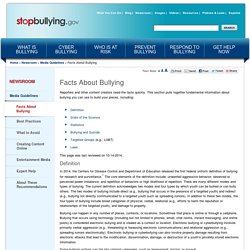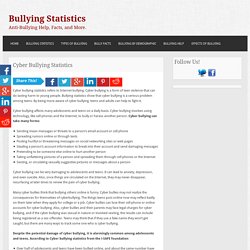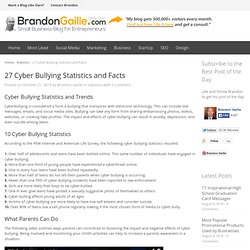

Teens. THE CYBER BULLYING VIRUS. Cyberbully PSA - Talent Show. Facts About Bullying. Reporters and other content creators need the facts quickly.

This section pulls together fundamental information about bullying you can use to build your pieces, including: This page was last reviewed on 10-14-2014. Definition In 2014, the Centers for Disease Control and Department of Education released the first federal uniform definition of bullying for research and surveillance.1 The core elements of the definition include: unwanted aggressive behavior; observed or perceived power imbalance; and repetition of behaviors or high likelihood of repetition. There are many different modes and types of bullying.
Bullying can happen in any number of places, contexts, or locations. Some bullying actions can fall into criminal categories, such as harassment, hazing, or assault. Journalists and other content creators can use this definition to determine whether an incident they are covering is actually bullying. State of the Science. Statistics on Bullying, Cyberbullying and Suicide. Traditional Bullying Nearly 1 in 3 students (27.8%) report being bullied during the school year (National Center for Educational Statistics, 2013).

The National Crime Victimization Survey of the 2011 school year found that 27.8% of students (ages12-18) reported being bullied at school, while 9% reported being cyber-bullied anywhere (NCES, 2013). Of the students that reported being bullied in the National Crime Victimization Survey (NCES, 2013): 64.5% said it was once or twice in the school year18.5% said once or twice a month9.2% said once or twice a week7.8% said almost every day Of the students in the National Crime Victimization Survey (NCES, 2013): 17.6% reported being made fun of, called names or insulted18.3% had rumors spread about them5.0% were threatened with harm7.9% were pushed, shoved, tripped, or spit on3.3% were tried to make do things they did not want to do5.5% were excluded from activities on purpose2.8% had their property destroyed on purpose.
Cyber Bullying Statistics. Cyber bullying statistics refers to Internet bullying.

Cyber bullying is a form of teen violence that can do lasting harm to young people. Bullying statistics show that cyber bullying is a serious problem among teens. By being more aware of cyber bullying, teens and adults can help to fight it. 27 Cyber Bullying Statistics and Facts. Cyber Bullying Statistics and Trends Cyberbullying is considered a form a bullying that transpires with electronic technology.

This can include text messages, emails, and social media sites. Bullying can take any form from sharing embarrassing photos, videos, websites, or creating fake profiles. The impact and effects of cyber bullying can result in anxiety, depression, and even suicide among teens. The Golden Spoons: MiniVan Conversations: T-H-I-N-K.
I don't know what it is about being in our minivan that almost instantly incites an altercation between my girls - especially between the oldest two.

As soon as they get in from the carpool line after school, it starts. Someone says the other is annoying. One tells the other to shut up. They argue over who sits where. They argue over what to listen to on the radio. Last week, we were driving across town to a retirement home where all three girls were taking part in a performance with the children's choirs from our church. I was about to blow. I love this and I love planting the seed in my kids that they should always think before they speak. T- Is it True?? H - Is it helpful? I - I changed this one to "Is it Intelligent?
" N - It is necessary? K - Is it Kind? I consider this a new twist on the old "If you can't say something nice, then, don't say anything at all" lesson. KEEP CALM AND THINK BEFORE YOU POST! Poster. Parent's Guide to Social Media - Babble. I finally joined Instagram, and then I fell down a rabbit hold of tween social media usage.

Some of what I found was innocuous, some was not. As soon as I joined, the app used my phone’s contact list to tell me who I might want to follow. Because many of my kids’ friends (and their parents) are in my contact list, Instagram had plenty of recommendations for me. The vast majority of both kids and adults that I found did not have their accounts set to private. By looking at the lists of who each kid was following, or was followed by, I was able to jump around pretty easily and see the photos of tons of kids I know, and kids I don’t know. From Instagram, I fell down a rabbit hole of social media sites. By searching Instagram for my kids’ school, I found a group where kids submit their photos to be “matched up” with a boy or girl from their grade.
I use social media every day, for both personal and professional reasons. Click the arrows to scroll through.